
The vision
“Are you sure you don’t want to just, you know, remove it?” the artist asks assertively.
I considered this before making my appointment at the open-air studio. It’s a relic from a bleak time, after all. But history wasn’t meant to be erased.
“Yep, let’s stick with the plan.”
I’m nervous I’ll prickle too much once the algae ink-coated needle pierces my forearm, now sun-loved and wrinkled. But the process ends up being way less painful than I remember.
After a couple of pokes, the tattoo of my youth, The climate changed, has a new ending: And so did we.
— a drabble by Emma Loewe
The spotlight
Roughly half of L.A. tattoo artist Sonny Robinson Bailey’s clients come to him for climate-themed tats: a motley crew of surfers, scuba divers, scientists, and environmental scholars no doubt lured by his Instagram bio: “tattoos for the climate concerned.”
Originally from the U.K., Robinson Bailey started focusing on climate tattoos after moving to the U.S. and feeling overwhelmed by all the waste he saw. Some of his designs are quite dramatic (think: a cartoon sun with burning-hot lasers coming out of its eyes; “MINDLESS CONSUMPTION” written in commanding letters), while others are more subtle nods to planetary thresholds and tipping points.
“I did a flash tattoo day a couple of years ago where I wrote a few paragraphs of facts and figures about the climate, put all the numbers in boxes, and tattooed them on people,” he told me on a video call. Five people showed up to get inked with numbers such as .9 (projected sea level rise by the end of the 21st century, in meters) and 1.5° (the warming threshold set forth in the Paris Agreement, in Celsius).
He added a new tattoo to his personal collection that day, too, he said, maneuvering the camera to show me the 2.12° above his left elbow — the approximate amount that global temps have risen since the Industrial Revolution, in Fahrenheit.
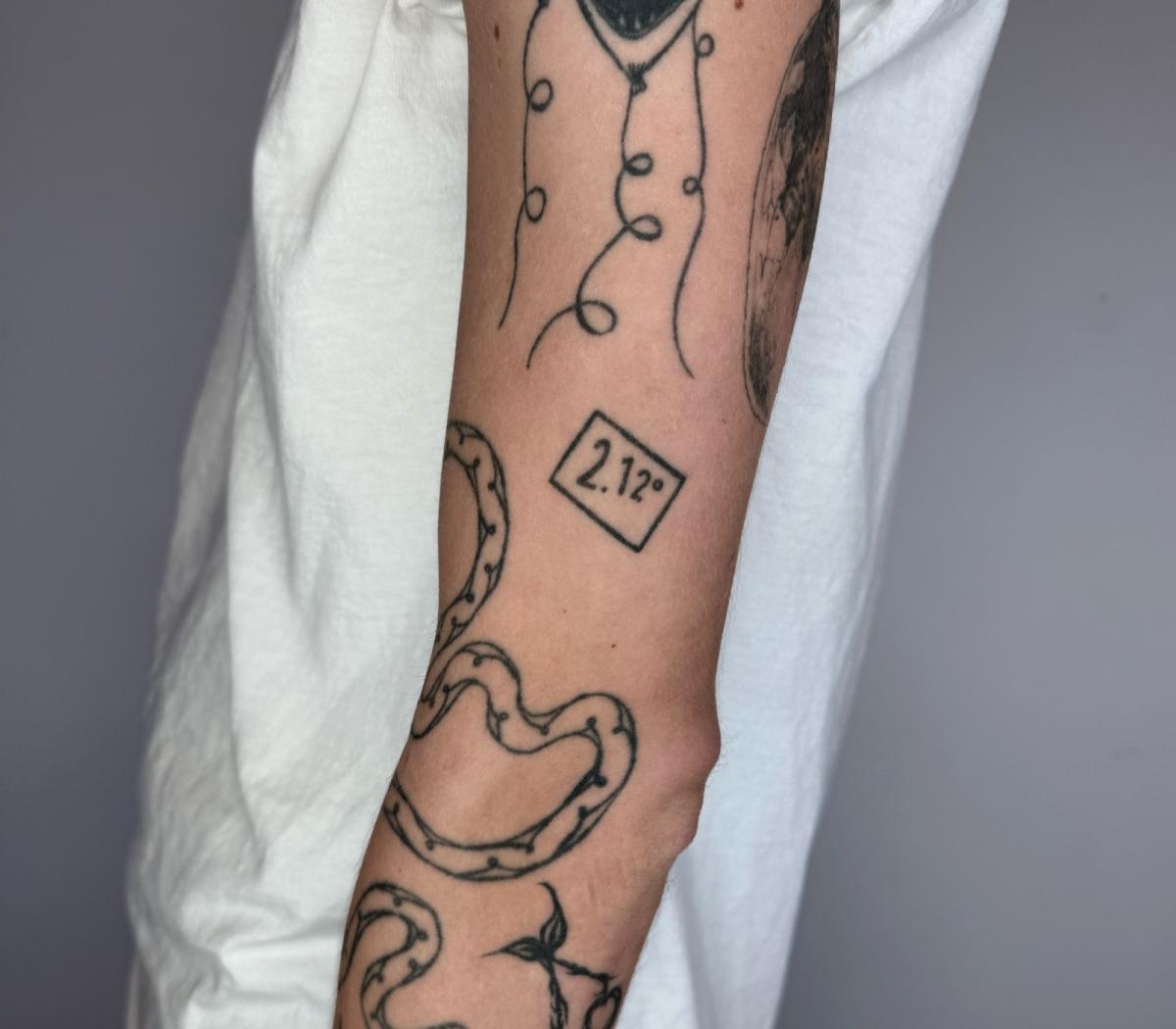
Sonny Robinson Bailey’s “2.12” tattoo. Courtesy of Sonny Robinson Bailey
While this figure will eventually become outdated, Robinson Bailey doesn’t mind. “I like to look at my tattoos as a journal,” he said. “[They] are always going to be a sign of the times.” And, he said, looking at it helps him sit in the discomfort of global warming. While many climate disasters feel far away when he reads about them in the news, tattoos “bring things back to reality.”
Robinson Bailey’s clients all have their own reasons for getting climate-themed tattoos. He recalls a researcher who asked for a coral tat to celebrate their work making reefs more resistant to heat waves, and a New Yorker who got the .9 sea level rise tattoo in solidarity with their threatened coastal city. Robinson Bailey said that talking to people about their connections to the climate is “the best part” of his job.
I took a page from his book and spoke with several people who have climate-themed tattoos about why they got them and what they represent. For some, they are reminders of what to fight for; for others, an ever-present reminder of what’s already lost. Almost all of them said they plan to get more. Here are their tats and the stories behind them.
![]()
Most of visual artist Justin Brice Guariglia’s photography, sculpture, and installation work explores human relationships with the natural world, built upon a foundation of climate science. So when he felt the itch to get tatted in 2016, it was only natural to turn to the latest NASA data for source material.
Sitting in a bean bag chair in his studio in downtown New York, Brice Guariglia pulled up his sleeve to reveal a NASA Surface Temperature Analysis graph climbing all the way up his right arm.
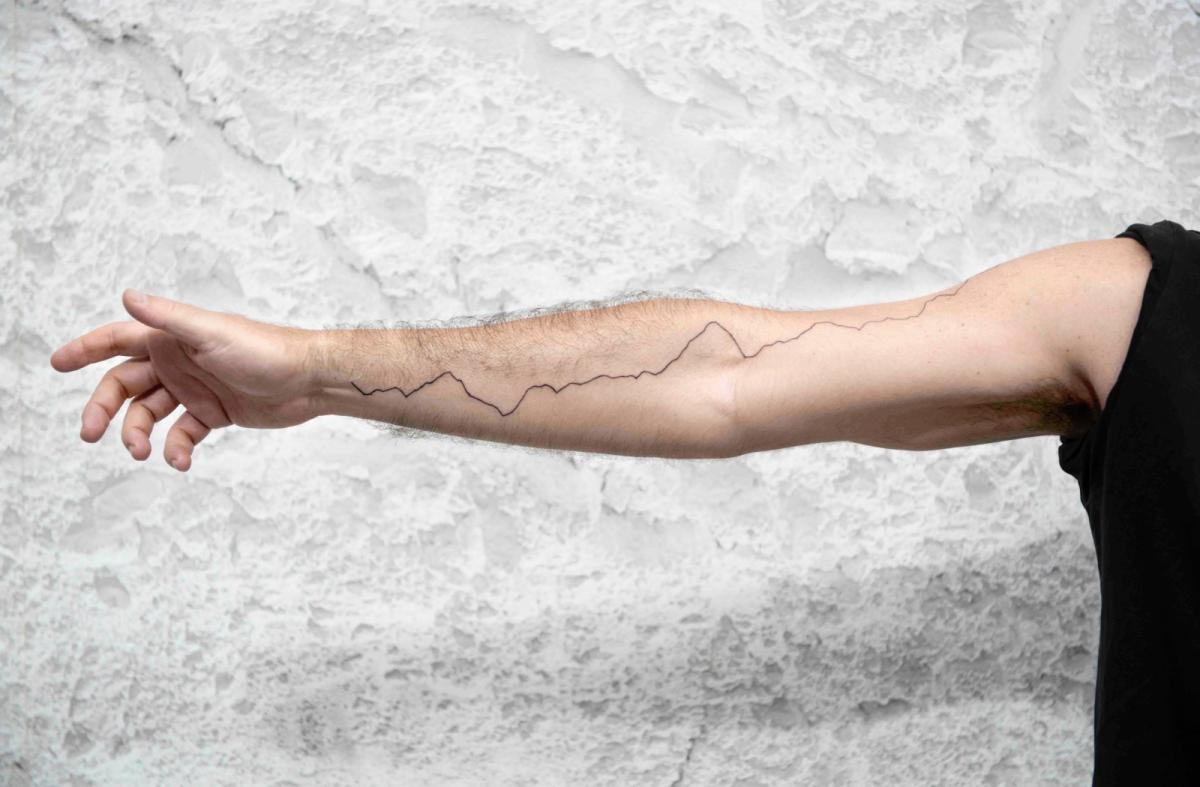
Justin Brice Guariglia’s Surface Temperature Analysis tattoo. Studio Justin Brice Guariglia
The tattoo, which shows the planet’s surface temperature from 1880 to 2016, is accurate and to scale. Brice Guariglia even emailed the scientist behind the work, James Hansen, for fact-checking before he made it permanent. “If you make art about climate or the environment, it’s so important to know the science,” he said. “Otherwise, it’s just decoration.”
Although his tattoo is essentially global warming immortalized, Brice Guariglia isn’t distressed when he looks at it — or when he explains it to others who inevitably mistake it for a mountain range or an electrocardiogram reading. “It doesn’t feel negative to me. If it felt negative, I wouldn’t have gotten it.” Instead, he said, it reminds him of his mission to keep working for a better future. “Climate change is the moral imperative of our time.”
![]()
Sanjana Paul is currently a graduate student at MIT focused on conflict negotiation in the energy transition, but she’s worn many hats throughout her career in climate. Trained as an electrical engineer, Paul (who was featured on the Grist 50 list in 2023) has collected atmospheric science data with NASA, hosted environmental hackathons, and pushed for climate policy as a community organizer.
The tattoo on her right ankle — the “ground” symbol, which resembles an upside-down T with two lines underneath — is a symbol for her of what has been constant throughout these diverse experiences.
“In circuit diagrams, the ground symbol is where the electric potential of the circuit is zero, so it’s your starting point,” she explained. She got the tat after she graduated from engineering school as a way to mark the starting point of her new career. Now, it nudges her to stay “grounded” — that is, motivated by her deep love for the planet — as she engages in different forms of climate work. And, she added, “In all seriousness, it was just funny.”
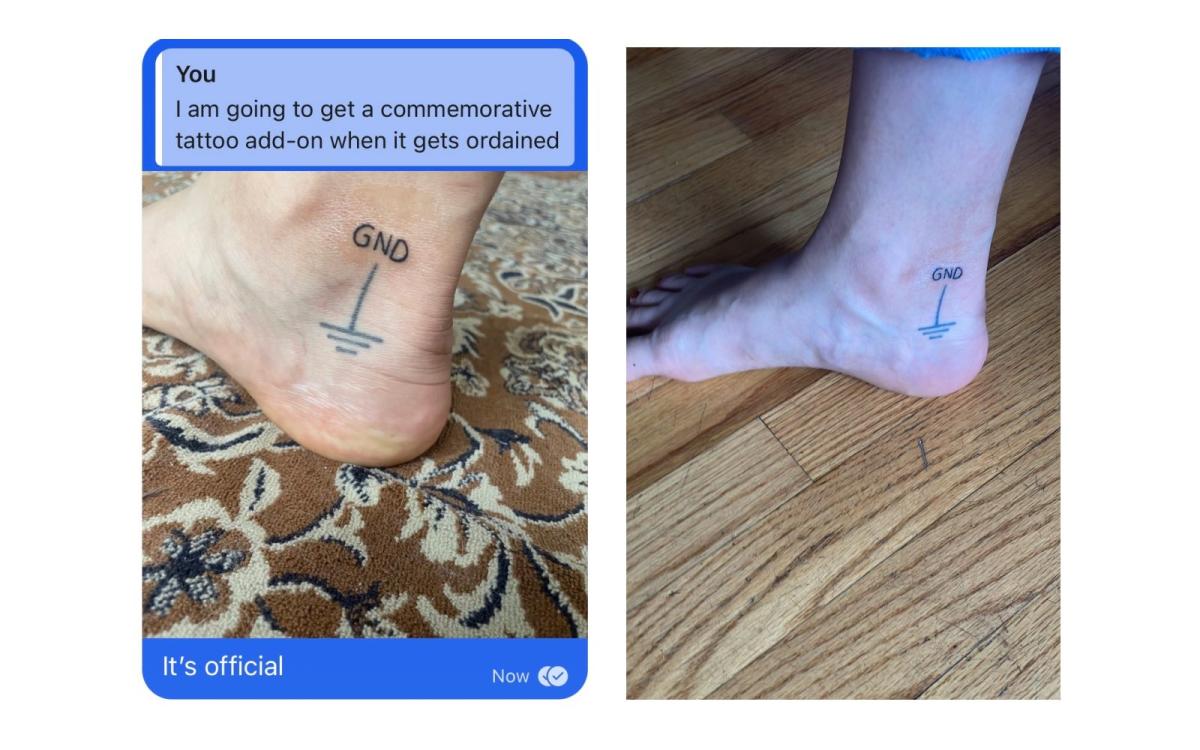
Sanjana Paul’s ground symbol and Green New Deal tattoos. Courtesy of Sanjana Paul
As for the “GND” letters above it, Paul added those after her community successfully advocated for a Green New Deal in Cambridge, Massachusetts — a package of environmental policies that passed the legislature in 2023.
“It took us two years of concerted effort,” Paul said. “[The tattoo] was kind of a commemorative thing to say, ‘We did it.’” She still has a screenshot of the photo of it she sent to her group chat when the legislation passed.
Paul, who also has a likeness of the NASA satellite Calipso on her arm, is currently dreaming up her next climate tattoo: an ode to the North Atlantic Ocean in honor of an offshore wind project she’s involved with. The tattoos in her growing collection are reminders of the unexpected places her work has taken her, and she also considers them gateways into climate conversations with all types of new people who ask about what the designs mean.
![]()
France-based photographer Mary-Lou Mauricio started something of a movement two years ago, when she began taking photographs for a campaign she called “Born in … PPM.” In the lead-up to COP27, the 2022 U.N. climate summit, she used temporary makeup to “tattoo” subjects with the measurement of the parts per million of CO2 in the atmosphere the year they were born — a way to capture just how much our overreliance on fossil fuels has changed the Earth’s chemistry — and photographed portraits of them.
The campaign caught on, and to date, she has collected over 4,000 images of people all around the world who have marked their personal ppm on their hands, faces, and stomachs. The portraits offer a way to visualize rapidly rising global greenhouse gas emissions, particularly when older subjects are juxtaposed with younger ones.
She knows of at least two people who have gotten their numbers permanently inked — and she has as well.
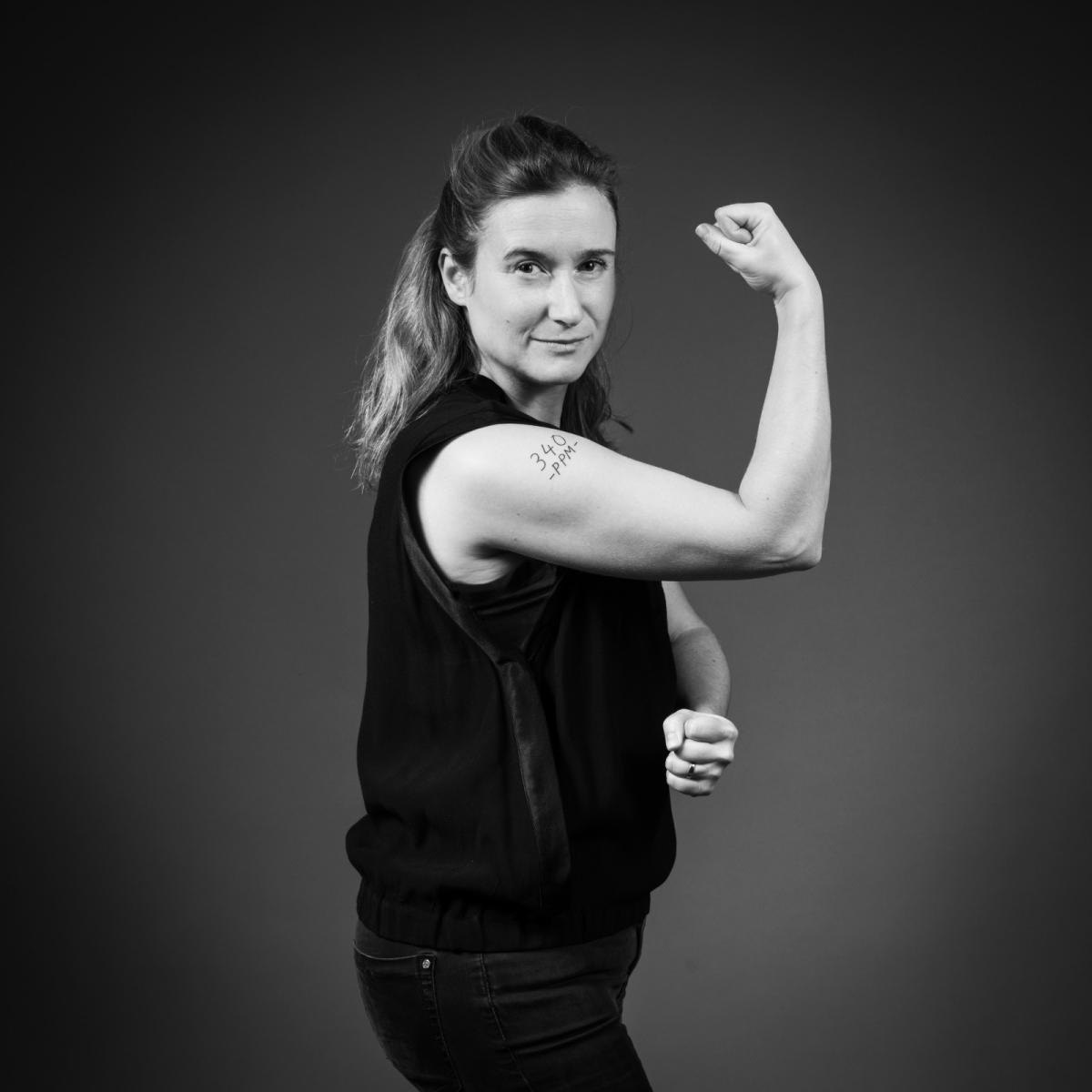
Mary-Lou Mauricio’s ppm tattoo. “Born in … PPM” / Mary-Lou Mauricio
For Mauricio, the 340 ppm tattoo on her right shoulder represents the marks that climate change has already left on her and her family. “My parents live in the south of Portugal, where droughts are becoming increasingly severe,” she said. “In 2022, a fire ravaged my parents’ region. … Sometimes they call me when it’s raining, because it’s becoming so rare.”
She told me that this ppm tattoo likely won’t be her last: “I’d like to add the ppms of my children’s births, because they’re the ones I’m campaigning for.”
— Emma Loewe
More exposure
- Browse: a collection of images from the “Born In … PPM” series, by Mary-Lou Mauricio
- Watch: Justin Brice Guariglia’s TedX talk on the critical role that art plays in climate communications
- Read: more about the history and cultural significance of tattoos (Smithsonian Magazine)
- Watch: a short film exploring the movement to revive Indigenous tattoo traditions in Canada (Canadian Broadcasting Corporation)
A parting shot
A collage of flash tattoo designs by Sonny Robinson Bailey, featuring climate, sustainability, and conservation messages.
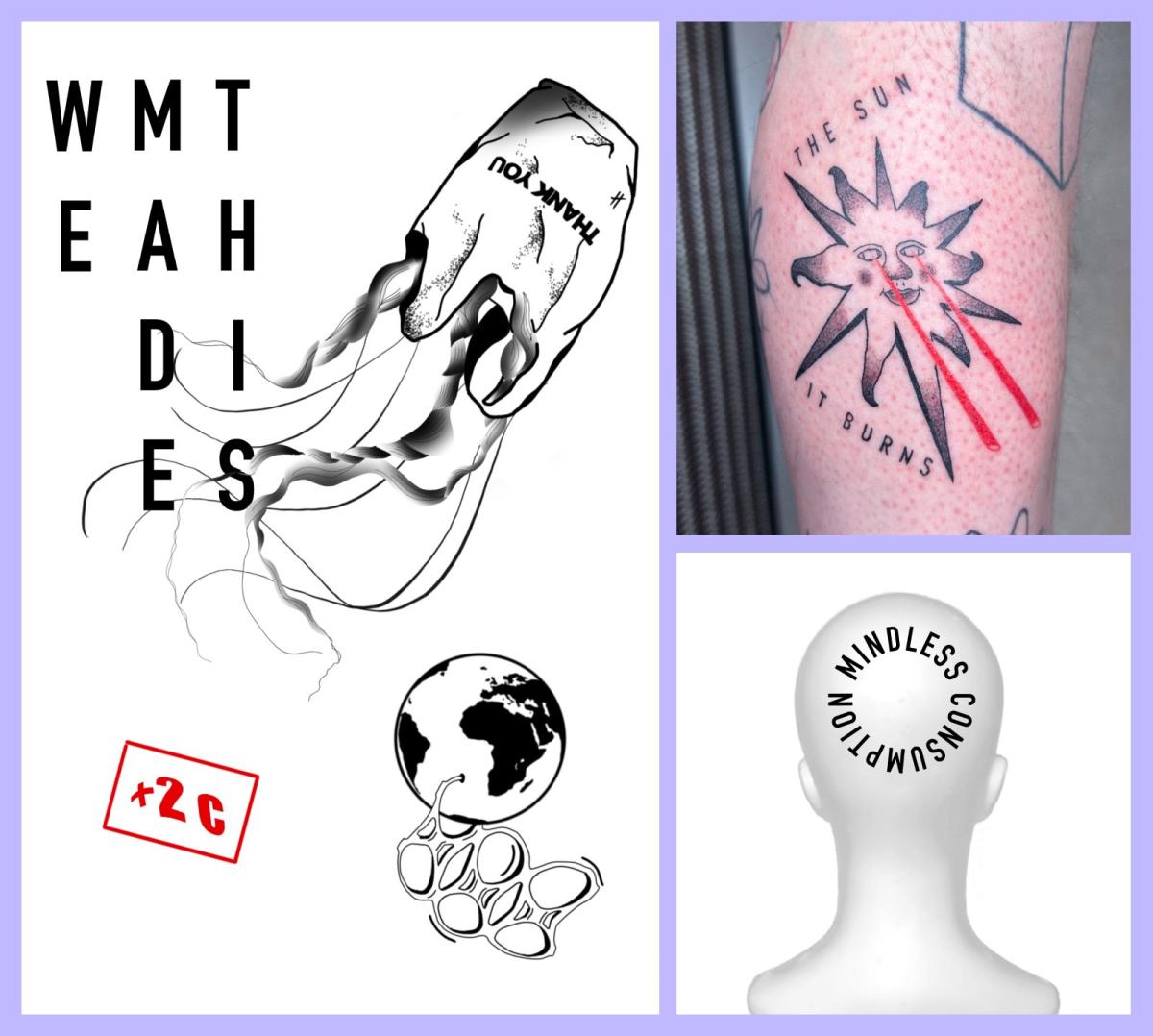
IMAGE CREDITS
Vision: Grist
Spotlight: Courtesy of Sonny Robinson Bailey; Studio Justin Brice Guariglia; Courtesy of Sanjana Paul; “Born in … PPM” / Mary-Lou Mauricio
Parting shot: Courtesy of Sonny Robinson Bailey



